[ad_1]
Our ‘On Location’ series reveals where some of the best loved art materials are made, and gives insight into art materials manufacturers’ working methods. This time we made our way to Germany to visit the Schmincke factory, where paint experts work to produce Mussini Resin Oil Colours, Horadam Watercolour, Primacryl Acrylics, and so much more.
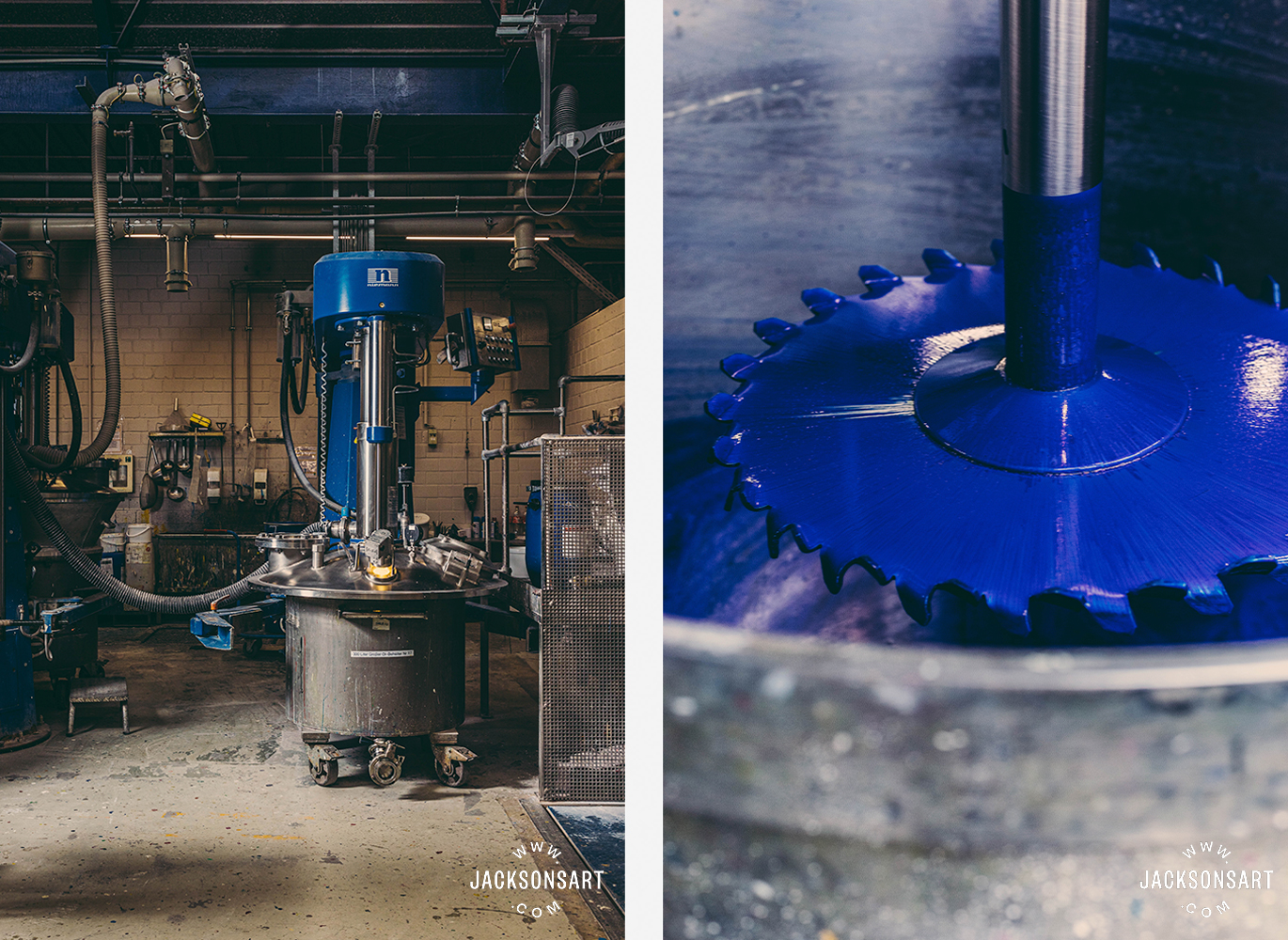
Schmincke Primacryl
Tucked away in an unassuming trading estate in Erkrath, Dusseldorf, lies the operations of one of the world’s most important manufacturers of artist’s colours; Schmincke. Founded over 140 years ago by chemists Hermann Schmincke and Josef Horadam, Schmincke started purely as a supplier of Old Master natural resin oil paints. Today it is a global brand, offering a vast array of high quality professional oil, acrylic, watercolour, pastel and printmaking colours and mediums.
First Impressions of the Schmincke Factory
Walking into the Schmincke factory for the first time, the first impression that is likely to hit you is its laboratory-grade cleanliness. All aspects of Schmincke’s operations are housed within one building – management, marketing, production and packaging – something that will eventually change as the company expands into the recently acquired building next door. Once you recover from your shock at the pristine floors and clinical white walls, you’ll notice a friendly and warm atmosphere – with no hint of hierarchy to our untrained eye. Everyone is treated with the same level of respect from the cleaner to the CEO.
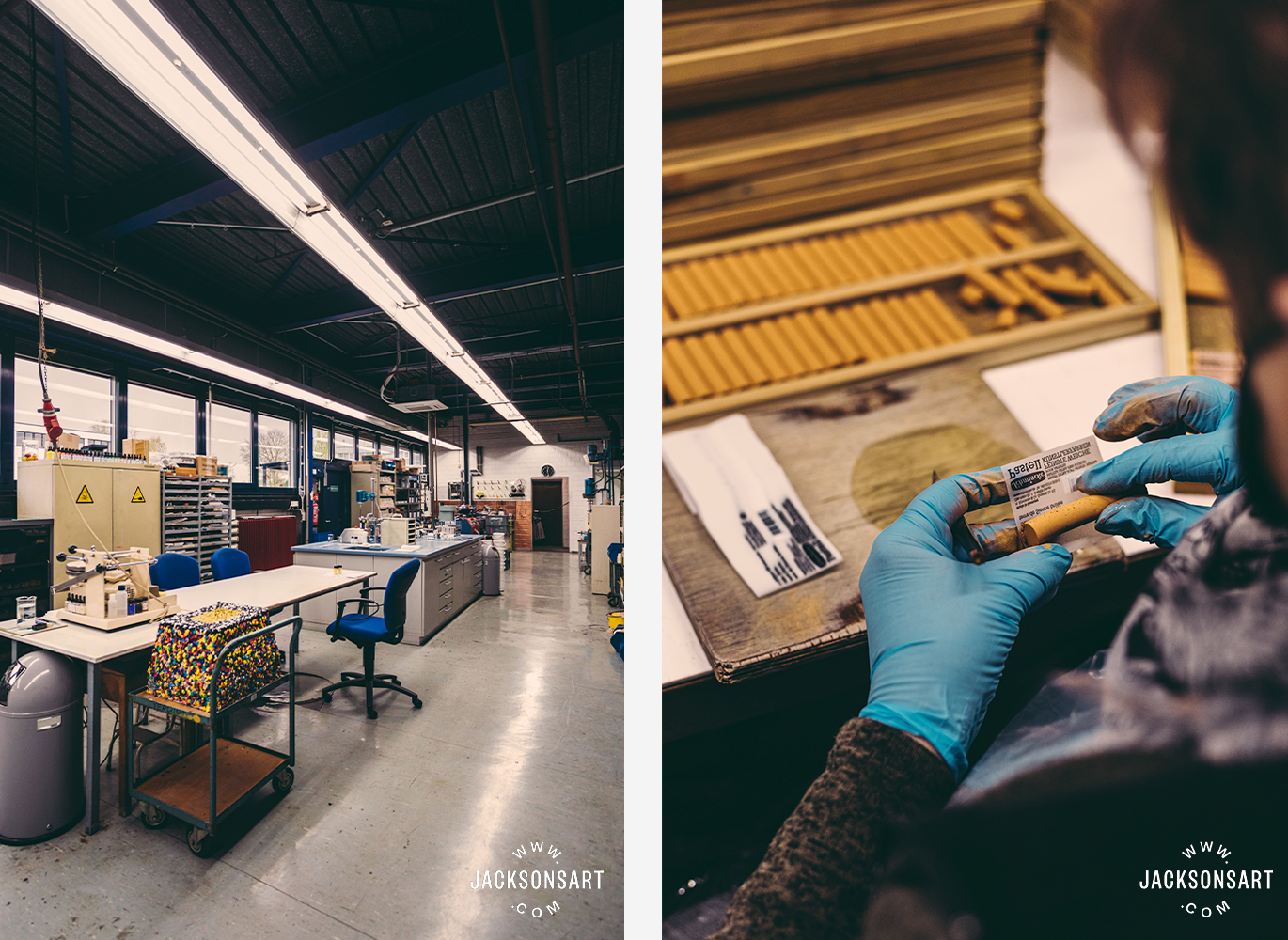
L – R: Schmincke lab, Schmincke Soft Pastels labelled and packed by hand
The offices of those in management and clerical roles at the Schmincke factory are at the front of the building, while the actual making of the paints is housed within a large open plan space, which is adjacent to other important operations, such as quality control, packaging, and the most magical of all, the pigment room. Above is a small museum dedicated to the history of Schmincke.
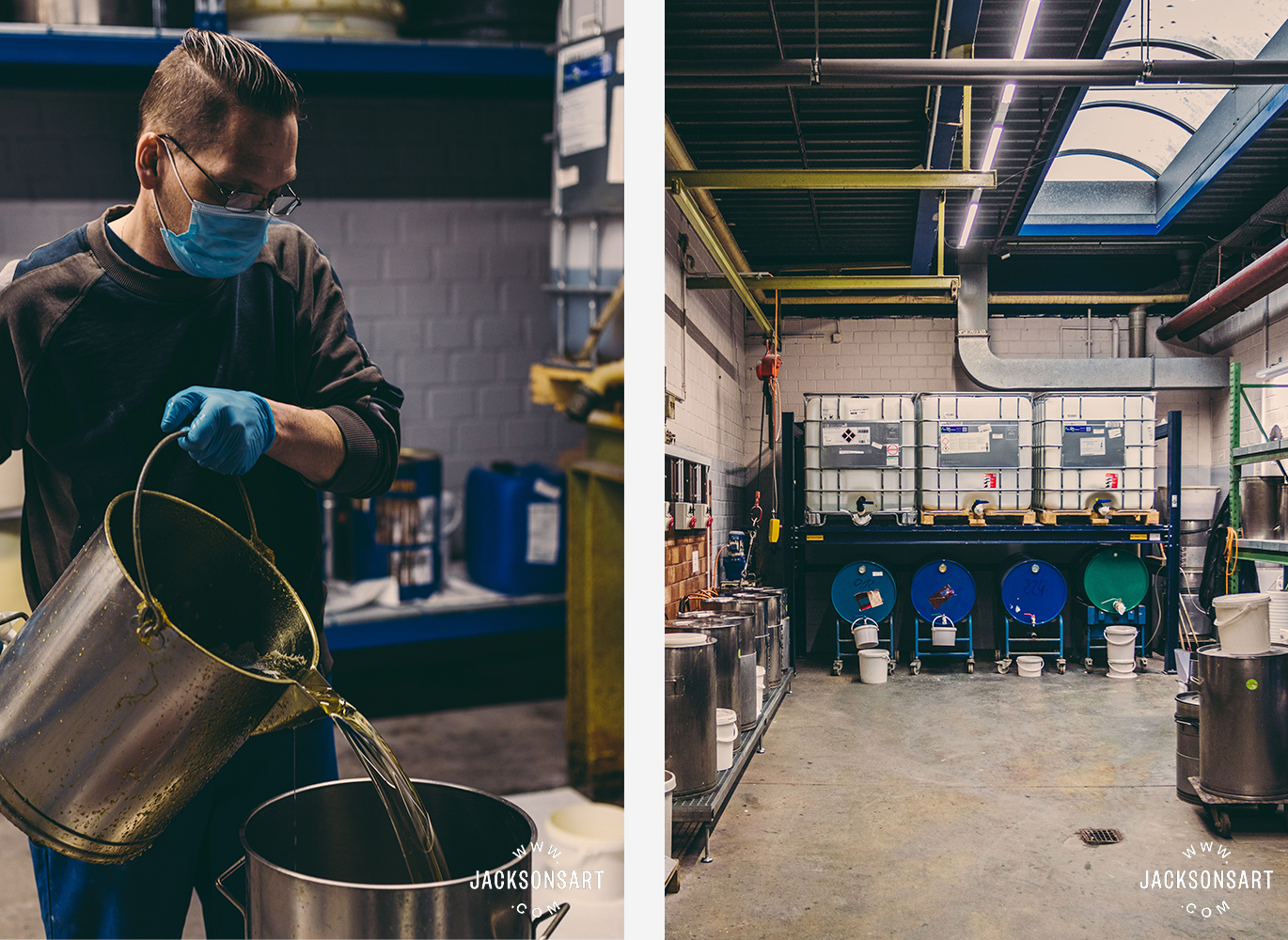
The oil room
Receiving Raw Materials for Paint Manufacture
The story of production at Schmincke begins at the Goods In room. Here all materials are delivered from external suppliers – everything from pigments, to binders, stabilisers and packaging. All deliveries are checked for quality and then bar coded so that everything can be tracked. Keeping a comprehensive record of what is coming into the factory is essential for maintaining good supply levels. These are measured weekly, with the aim of having around 4 months worth of stock on site at any one time, so that fluctuations in demand can be responded to in good time.
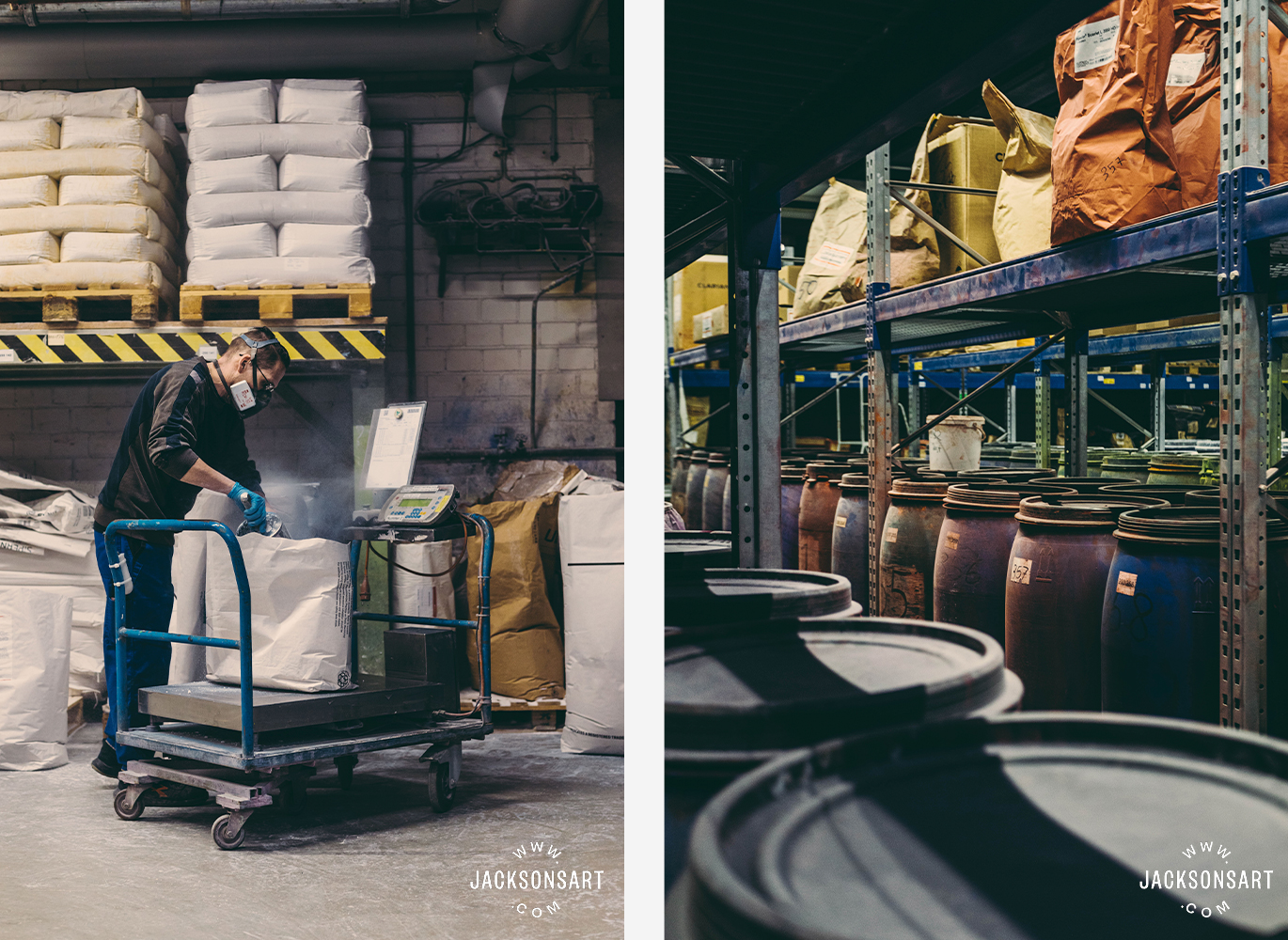
The pigment room
The Pigment Room at the Schmincke Factory
The raw materials store is a cavernous room which houses over 250 pigments, as well as all the other raw materials required for the production of all the various product lines made at the Schmincke factory. The pigments are kept within rows upon rows of large barrels, lightly dusted with the pigment powder. When the lids of these barrels are lifted the power of the intense colour hits your eyes for a visual experience like no other – photographs cannot do it justice. Factory workers drive in and out of the raw materials store on factory carts that hold a platform and scales as well as the all important list of ingredients for specific paints. They meticulously measure out the ingredients they require, and then drive through to the factory floor to begin making their batch.
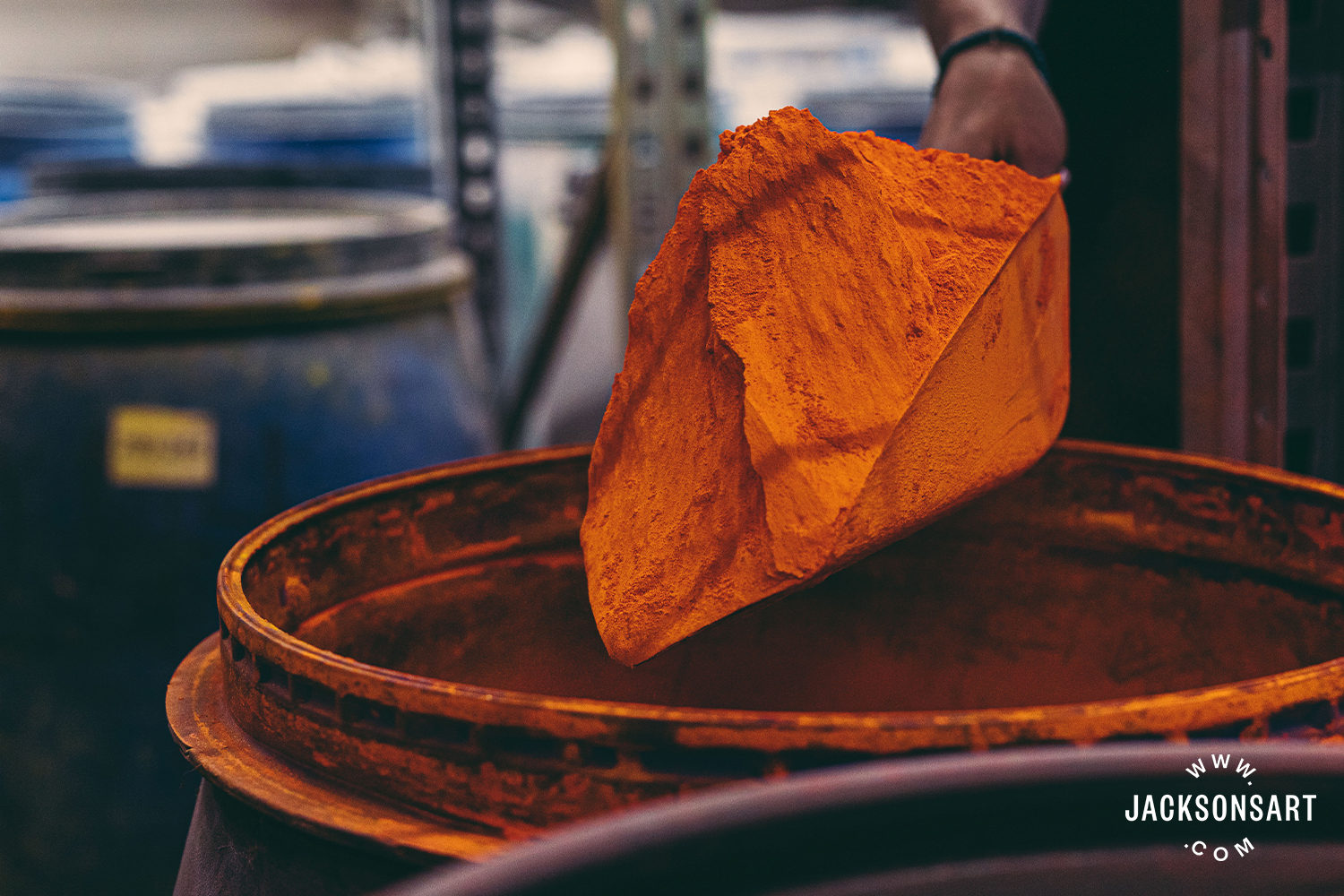
Schmincke Transparent Orange Pigment PO71
Mixing the Ingredients for Artist’s Paint
The first stage of making any artist paint is mixing all the ingredients together. The dry pigment is put into the drum of a mixing machine, and liquid ingredients – the oils, resins and stabilisers for oils; gum arabic, distilled water and dextrin for watercolour and soft pastel – are added gradually to the mix. Rotating teeth help to ensure that all the pigment is wetted with the liquid ingredients. Each colour has its own unique characteristics, and can take different amounts of time to become wetted and start to absorb some of the liquid ingredients. During our visit we had the opportunity to watch this process for a batch of Royal Blue Light Mussini resin-oil colour, which takes around 15 minutes to mix. The process can take up to 2 hours for other pigments.
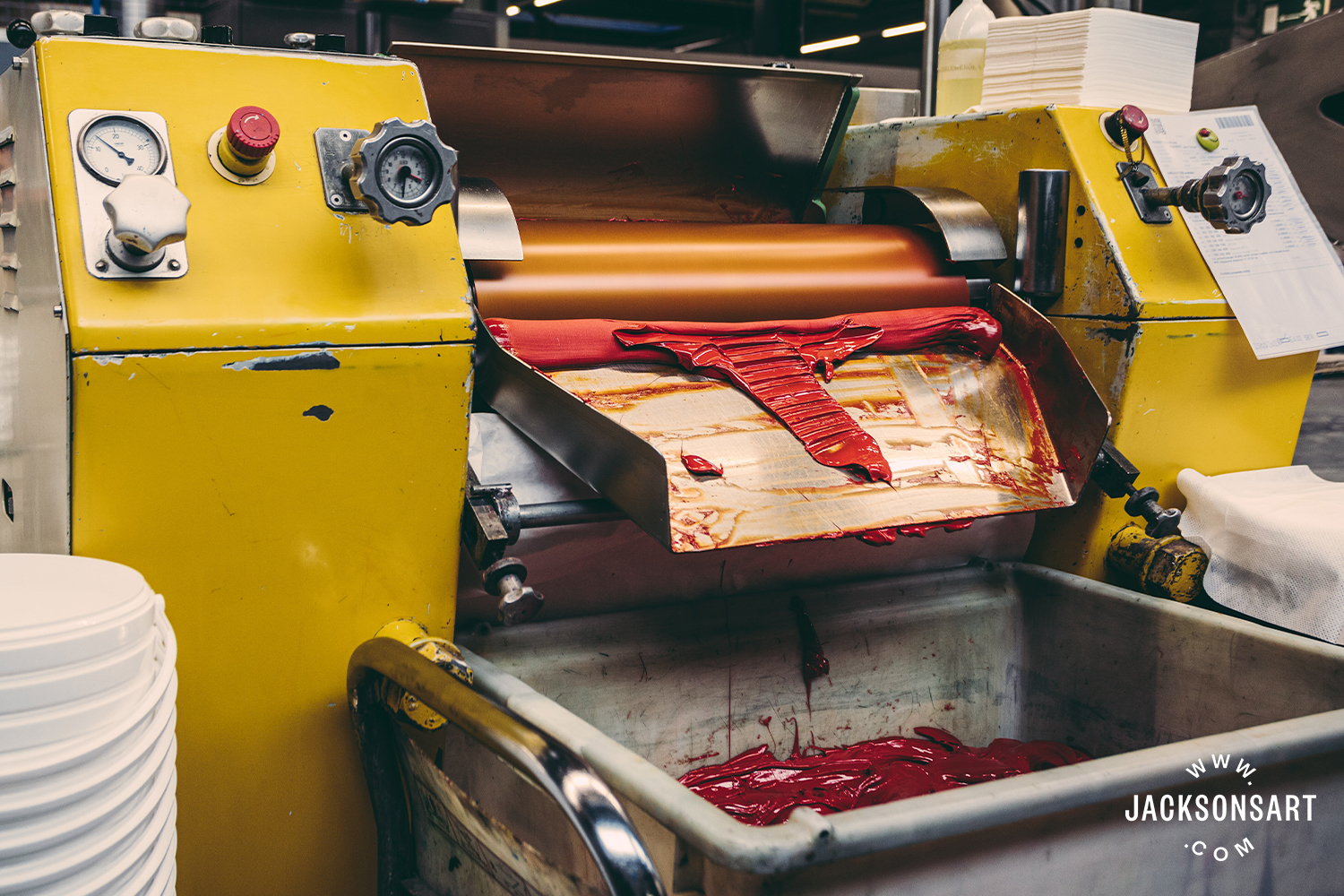
Schmincke Mussini Oil
The team works hard to keep equipment and surrounding areas clean, both during the mixing process and afterwards. This is essential for avoiding contamination of colours and to keep operations at maximum efficiency. The machines are cleaned with paraffin and special lint free cleaning tissues, on which the company spends around 10,000 Euros each year!
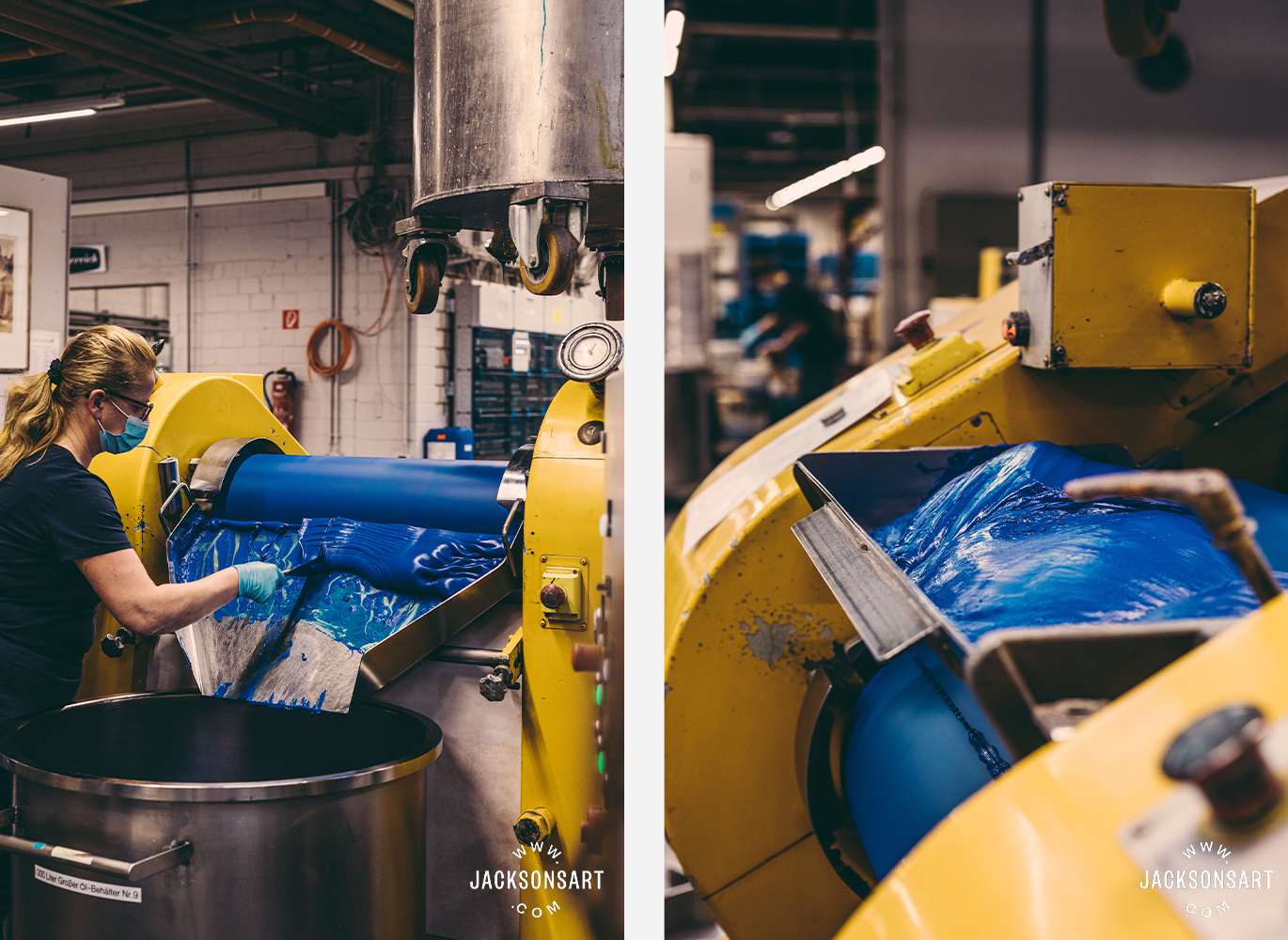
Schmincke Mussini Oil
The drums of paint formula are then taken to the grinding shop in another section of the Schmincke factory, where it is put through three-cylinder milling machines. The process is similar for oil, pastel and watercolour. Again, the amount of time that each colour spends in the milling machine depends on the pigment, and the binder it is in. Milling ensures that the pigment is dispersed evenly throughout the paint, and colours are often put through the milling machine several times – the harder pigments can go through the machine up to 5 times. The steel cylinders are temperature controlled so that the paint does not become too hot or cold for effective milling. Each machine is supervised and the paint is scraped off the machine with oversized palette knives into a big metal bucket. The paint looks oozy and delicious – presumably much like the liquid chocolate that these machines were originally built to mix!
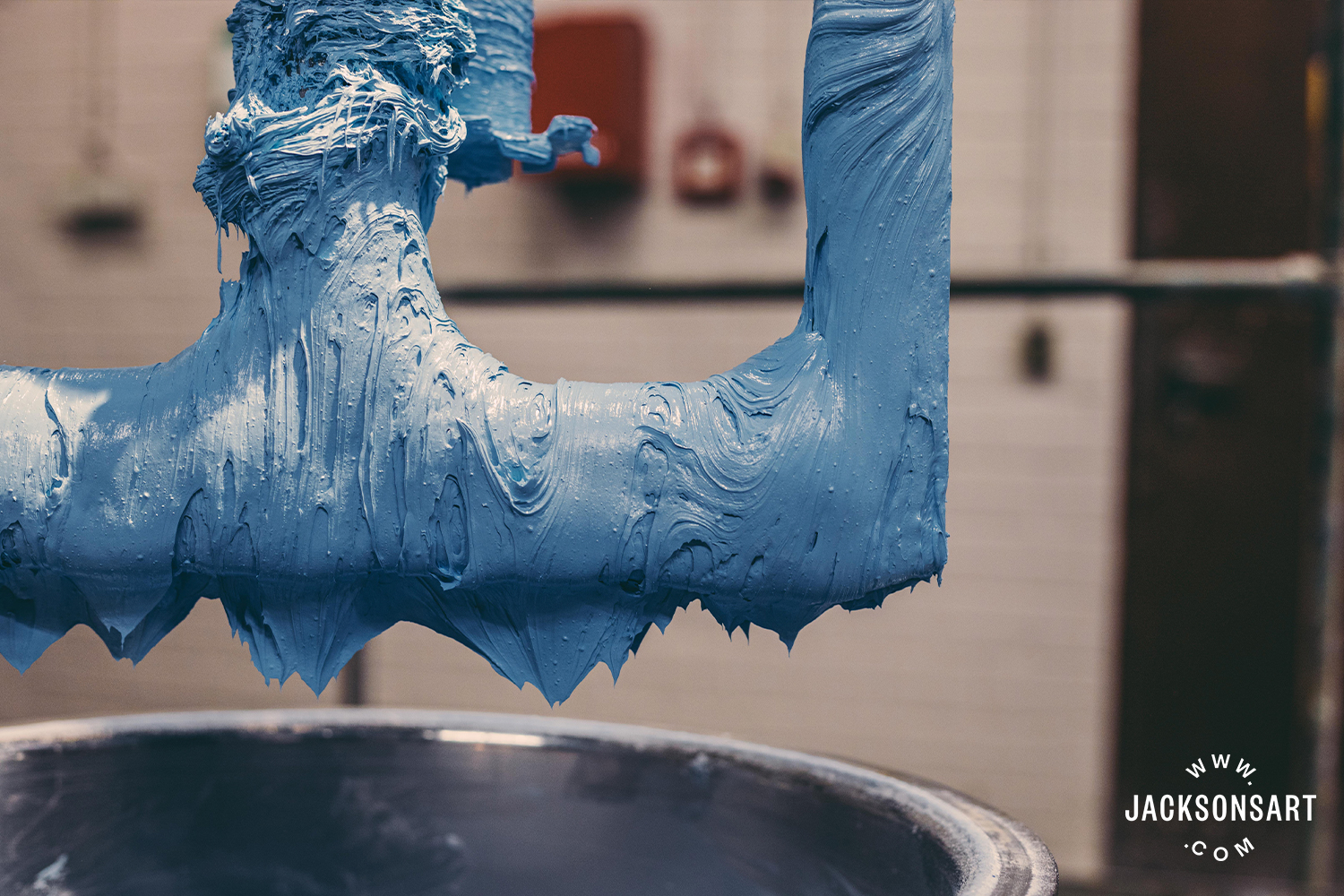
Schmincke Mussini Oil
How is Oil Paint is Manufactured?
For the milled oil paint, the next stage is resting. The oil paint is decanted into smaller airtight 8-10 kg plastic buckets and placed on shelves for several months. A layer of greaseproof paper is put on top of the paint and over the course of the resting time, the pigment will sweat out some of the liquid ingredients, and then reabsorb it, then sweat it out again, until an equilibrium is met. We were shown one of the buckets of Cadmium Red to find a layer of oil sat on top of the greaseproof paper. Once the paint has sat for sufficient time (again, dependent on each pigment and its absorbency), the excess liquid is syphoned off and the paint is taken to the filling station – a semi-automatic, supervised process to ensure each tube is well filled. Mussini resin-oils are then labelled by hand, and then boxed for distribution.
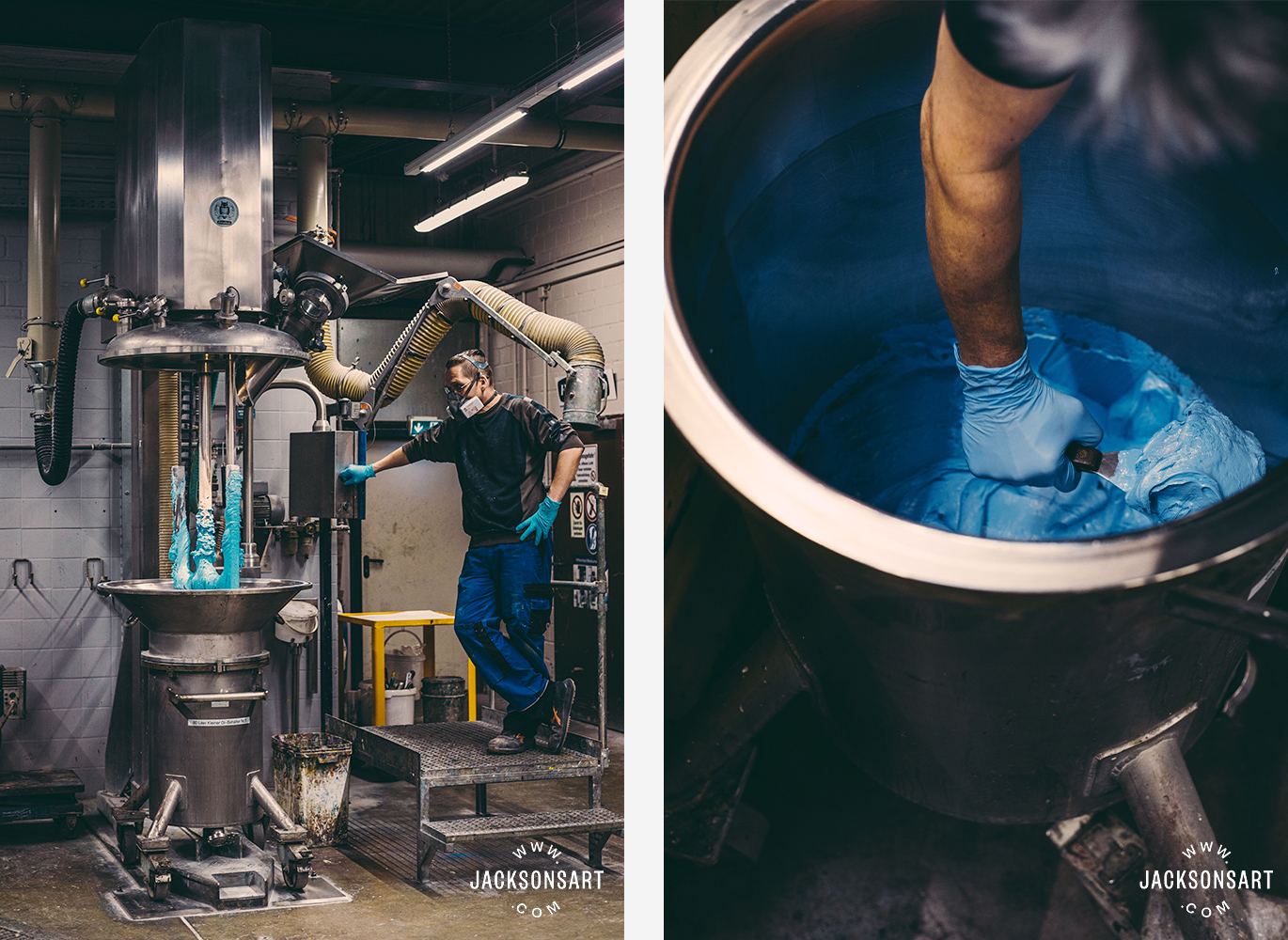

Schmincke Mussini Oil
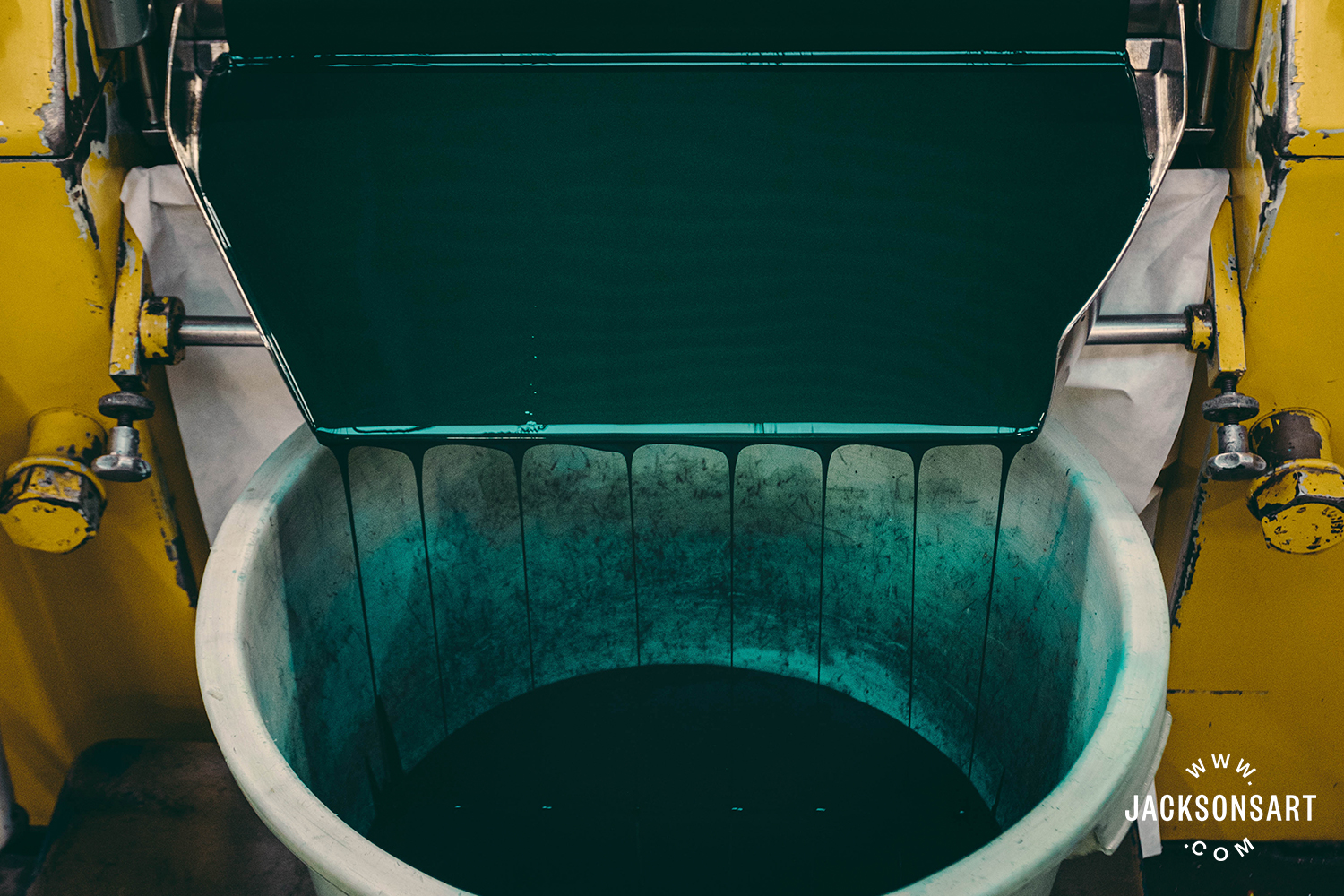
Schmincke Horadam Watercolour
How is the Watercolour Paint Manufactured?
Schmincke, unlike the majority of watercolour paint manufacturers, pour their Horadam watercolour paint into pans individually, and do this over the course of around 50 days. Rows of empty pans are filled with a machine that pours the paint little by little – usually in 4 doses, with 8-14 days waiting time in between each dose. After each filling, the pans are kept in an oven set to 37 degrees, to ensure the moisture in the paint evaporates evenly. The consequence of all this effort is a watercolour paint that is easy to rewet and is a pleasure to use. With every batch made, tests are conducted to ensure the quality before the pans are wrapped, labelled and boxed for distribution. Carrying on the association with chocolate, the former cellophane wrapping machine was originally built to wrap chocolate bonbons!

Schmincke Horadam Watercolour being mixed, and filled
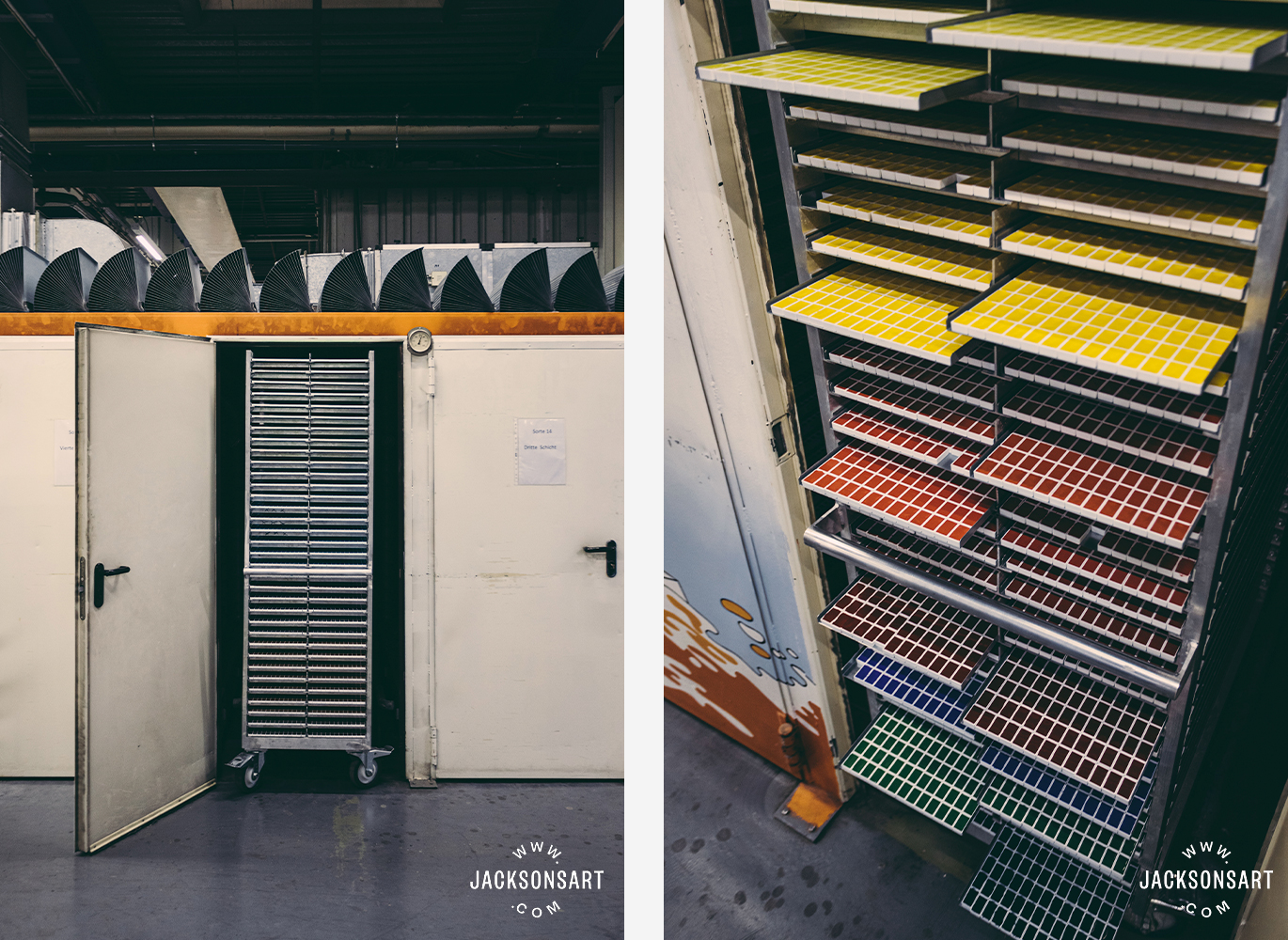
After each filling the pans are kept in an oven set to 37 degrees to ensure the moisture in the paint evaporates evenly.
A number of pans are taken to the sets assembly area in another corner of the Schmincke factory, where metal tins are filled with the right combinations of colours by hand – there are a wide number of sets with different colour palettes to cater for various markets, and so attention to detail is stretched to the maximum.

Schmincke Soft Pastels being cut into sticks using a wire frame.
How is the Soft Pastel Manufactured?
As you might expect, the ingredients for soft pastel contain less liquid than watercolour or oils, and so further mixing is carried out on a kneading machine. The blades in the machine are sharper and get even sharper with use! And so it is imperative that machine operators wear heavy duty gauntlets. Once the crumbly paste is at an even consistency it is put through the forming machine. Spiral rollers mould the pastel mix into long round strands, which are lined up side by side on a table by hand, before being cut into sticks using a wire frame. The pastel sticks are then left to dry at a specific temperature and humidity to guarantee the perfect conditions for making a soft, crumbly stick of colour. Because they are so soft the sticks need to be labelled and packed by hand by well practised individuals to avoid breakages.


Schmincke Soft Pastels Mixture

Schmincke Primacryl
How is the Acrylic Paint Manufactured?
The finest milled pigments, acrylic resin solution and water are mixed in huge vats at high speeds. The acrylic resin solution varies depending on whether the paint is Aero Color acrylic ink, Akademie Acryl or Primacryl acrylic paint. There is no need for the paint to rest – instead the colour is immediately filled in bottles or tubes using large machines. A similar process is involved in producing Schmincke’s acrylic gesso.

Specialist Products at Schmincke
In addition to all this, the Schmincke factory also manufactures their bronze powders, oil and acrylic mediums, liquid charcoal and lino print colours on site, adding to an impressive array of artist materials in production.

Schmincke Lab testing Schmincke Mussini Oil
Testing and Quality Control of Schmincke Paints
All batches of colour undergo rigorous testing, including analysis under a spectrometer (which ensures even pigment dispersion within a paint), a light fastness machine, and a drop shape analyser. In the rooms adjacent to testing, the product development team work continuously to find ways to improve existing brands, expand colour ranges, and develop innovative new products to introduce to the market.

Schmincke Lab testing Schmincke Mussini Oil
Schmincke’s Environmental Policy
Schmincke is an environmentally conscious company. The roof of the Schmincke factory is laden with solar panels, which produces 70% of the energy required for factory operations (the rest of the energy used is gas). They aim to minimise waste in production, producing ‘Random Grey’ paint with leftover pigment blends, in the past as an oil colour, and most recently as a watercolour special edition. They have a commitment to using renewable raw materials in production where possible, and recycle and use recyclable materials for packaging.

Schmincke Mussini Oil Tubes
With their vast output of different artist materials all in production at one site, the Schmincke factory is a special place, and a treat for any artist to witness.
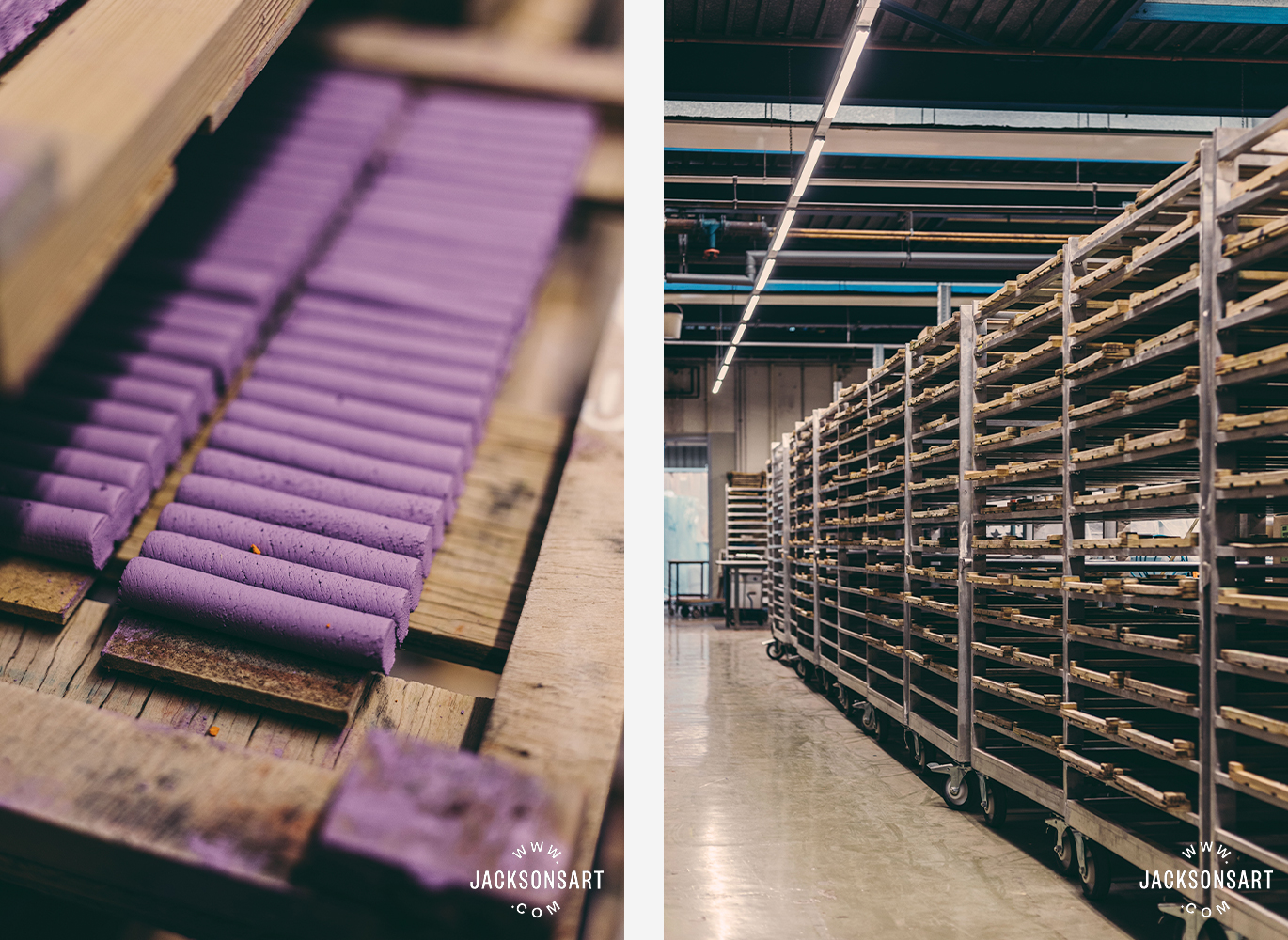
Schmincke Soft Pastels
We hope you’ve enjoyed visiting vicariously through this feature! We’d love to hear which Schmincke products you enjoy working with and which you’re intrigued to try out next – let us know in the comments below.

Schmincke Soft Pastels
Contents
0:00 Introduction
Schmincke Horadam Watercolour and Super Granulation Colours
0:24 Introduction
0:36 The Oil and Resin Room
0:53 The Pigment Room
1:17 Mixing the Ingredients
2:19 Milling Schmincke Horadam Watercolour
2:56 Filling – Rows of empty pans are filled with a machine that pours the paint little by little – usually in 4 doses, with 8-14 days waiting time in between each dose.
3:29 After each filling, the pans are kept in an oven set to 37 degrees, to ensure the moisture in the paint evaporates evenly.
3:46 Filling
4:31 Packaging
5:20 The Schmincke Lab – Testing Schmincke Horadam Watercolour and Super Granulation Colours
Schmincke Mussini Oil
5:53 Introduction
5:58 The Oil and Resin Room
6:28 The Pigment Room
7:00 Mixing Schmincke Mussini Oil
8:02 Milling
9:21 Resting
9:38 Filling Schmincke Mussini Oil into Tubes
10:21 The Schmincke Lab – Testing Schmincke Mussini Oil
Schmincke Soft Pastel
11:02 Introduction
11:25 Mixing the Ingredients in Kneading Machine
12:42 Making and Cutting Soft Pastels
13:19 Drying
13:31 Packaging
13:59 The Schmincke Lab – Testing Schmincke Soft Pastels
Schmincke Aero Color Fluid Acrylic Ink
14:27 Introduction
14:31 Mixing the Ingredients
15:14 Filling
15:28 Packaging
16:01 The Schmincke Lab – Testing Schmincke Aero Color Fluid Acrylic Ink
Schmincke Primacryl Artists’ Acrylic
16:40 Introduction
16:52 Mixing
17:12 Filling and Packaging
17:47 The Schmincke Lab – Testing Schmincke Primacryl Artists’ Acrylic
Schmincke Aqua Bronze Powder
18:08 Introduction
18:18 Filling
18:43 Packaging Schmincke Aqua Bronze Powder
19:00 Credits
Further Reading
In Conversation With Markus Baumgart of Schmincke
On Location at Unison Colour
In Conversation With Suzi Morris: Schmincke Mussini Oil Colours
Shop Schmincke on jacksonsart.com
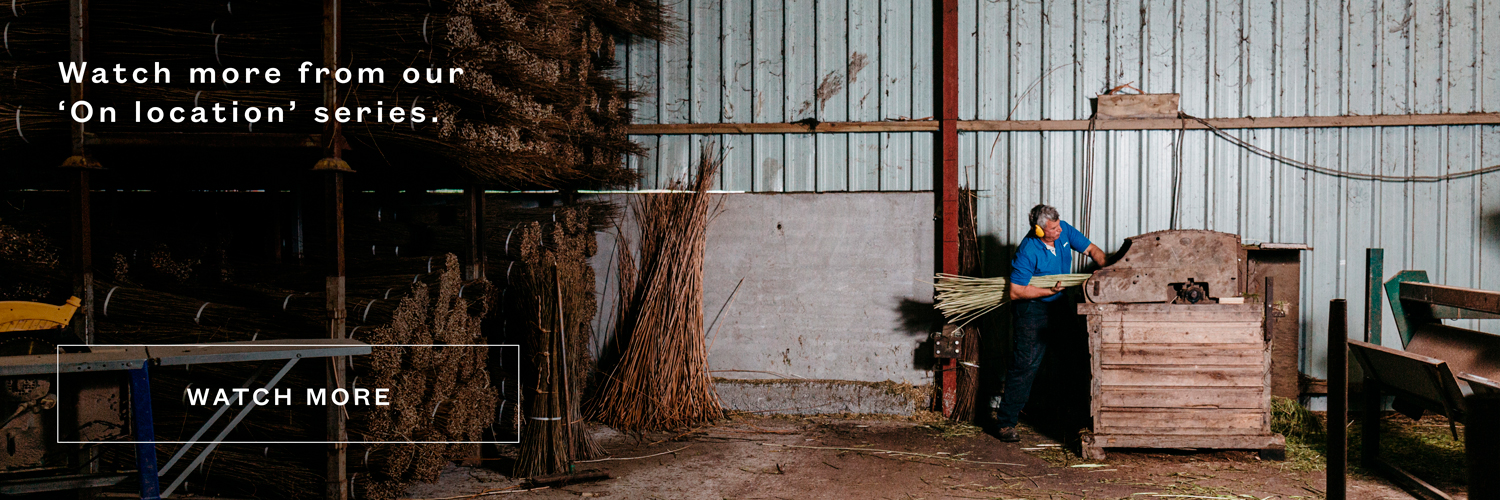
[ad_2]
Source link


